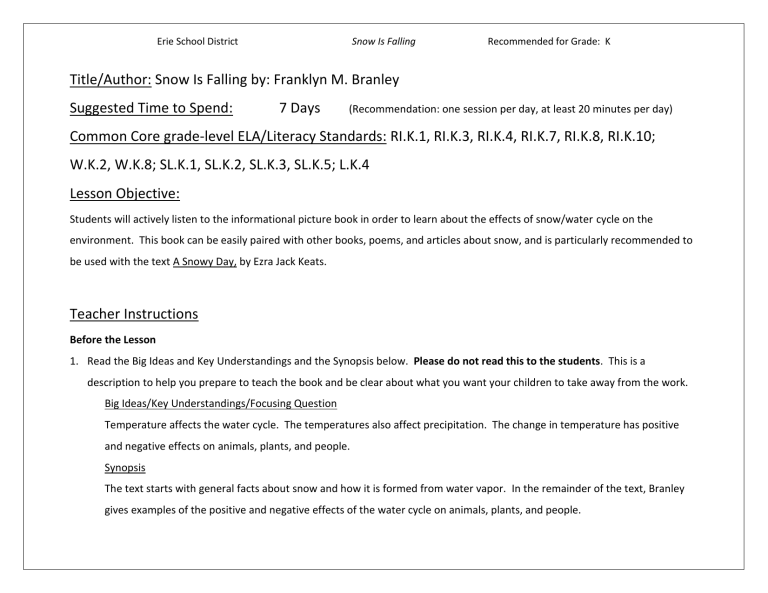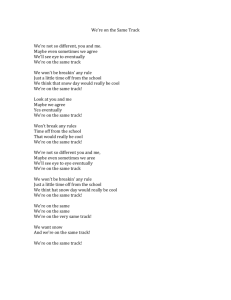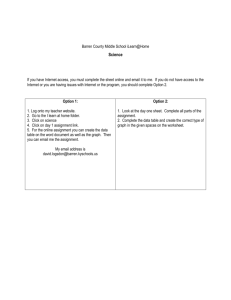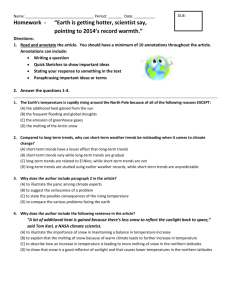Snow Is Falling - Achieve the Core

Erie School District Snow Is Falling
Title/Author: Snow Is Falling by: Franklyn M. Branley
Recommended for Grade: K
Suggested Time to Spend: 7 Days
(Recommendation: one session per day, at least 20 minutes per day)
Common Core grade-level ELA/Literacy Standards: RI.K.1, RI.K.3, RI.K.4, RI.K.7, RI.K.8, RI.K.10;
W.K.2, W.K.8; SL.K.1, SL.K.2, SL.K.3, SL.K.5; L.K.4
Lesson Objective:
Students will actively listen to the informational picture book in order to learn about the effects of snow/water cycle on the environment. This book can be easily paired with other books, poems, and articles about snow, and is particularly recommended to be used with the text A Snowy Day, by Ezra Jack Keats.
Teacher Instructions
Before the Lesson
1.
Read the Big Ideas and Key Understandings and the Synopsis below. Please do not read this to the students. This is a description to help you prepare to teach the book and be clear about what you want your children to take away from the work.
Big Ideas/Key Understandings/Focusing Question
Temperature affects the water cycle. The temperatures also affect precipitation. The change in temperature has positive and negative effects on animals, plants, and people.
Synopsis
The text starts with general facts about snow and how it is formed from water vapor. In the remainder of the text, Branley gives examples of the positive and negative effects of the water cycle on animals, plants, and people.
Erie School District Snow Is Falling Recommended for Grade: K
2.
Go to the last page of the lesson and review “What makes this Read-Aloud Complex.” This was created for you as part of the lesson and will give you guidance about what the lesson writers saw as the sources of complexity or key access points for this book. You will of course evaluate text complexity with your own students in mind, and make adjustments to the lesson pacing and even the suggested activities and questions.
3.
Read the entire book, adding your own insights to the understandings identified. Also note the stopping points for the textinspired questions and activities. Hint: you may want to copy the questions vocabulary words and activities over onto sticky notes so they can be stuck to the right pages for each day’s questions and vocabulary work.
The Lesson – Questions, Activities, and Tasks
Questions/Activities/Vocabulary/Tasks
FIRST READING:
Pull the students together or use a document camera so that all students can enjoy the illustrations. Read aloud the entire text Snow Is Falling with minimal interruptions.
Stop to provide word meanings or clarify only when you know the majority of your students will be confused.
SECOND READING:
Reread P. 1-5
The author states that “snow is falling.” What does that mean? Explain how the text describes how the snow falls and where it falls.
Reread P. 6-7
The author states “everything is covered”. What does
Expected Outcome or Response (for each)
The goal here is for students to enjoy the text, both writing and pictures, and to experience it as a whole. This will give them some context and sense of completion before they dive into examining the parts of the text more carefully.
“Snow is falling” means that the snow is dropping/coming down.
The text describes the snow as quiet. The snow falls without a sound.
The snow is falling in front of the streetlight. It may fall all night.
Covered means to lie on the surface of, to blanket. Lawns, trees, roofs
Erie School District covered mean? What is covered and what in the text helps us to understand what is covered?
Reread P. 8-9
Water vapor forms when water heats up and turns into steam and disappears; you can no longer see it with your eyes. What causes water vapor to turn into snowflakes?
Snow does not always fall the same way. What are some of the different ways snow can fall?
Using the illustrations and text, explain how snowflakes are the same and different.
Snow Is Falling Recommended for Grade: K of houses are covered. Everything is covered. The text tells us that lawns, trees, and roofs of houses are white, which means that snow has fallen on them.
It is so cold that water vapor freezes in the air. This makes snowflakes.
Snowflakes stick together and fall as a cluster of flakes. They can also fall as single flakes. (see examples on page 9)
Some examples may include:
Same: Each snowflake has six sides. They are white. They have a center point.
Differences: Students would describe the different shapes of the snow crystals.
Activity:
For Students living in a climate in which it snows:
Provide students with “Types of Snowflakes Chart.” See the link below.
Discuss the chart with students. Have the students “collect” snowflakes on a piece of black construction paper. Discuss which types of snowflakes they saw. http://www.its.caltech.edu/~atomic/snowcrystals/kids/snowtypes.pdf
For Students living in a climate in which there is not snow:
Provide students with the pictures of the different types of snowflakes.
Identify the names of the snowflakes with the pictures. See the link below. http://www.its.caltech.edu/~atomic/snowcrystals/kids/samplecrystals.jpg
Erie School District Snow Is Falling Recommended for Grade: K
THIRD READING:
Reread P. 10-11
Listen to this sentence. “When you walk in wet, sticky snow, you splash, and slip, and slide.” How did the author describe the snow?
How many ways did the author explain that you could walk in the wet, sticky snow? What were they?
Listen to this sentence. “Sometimes snow is light, dry, and fluffy.” How many different words did the author use to describe the snow? What were they?
FOURTH READING:
Reread P. 12-13
The author switches from telling us information to asking us questions. The author uses questions to focus our attention on what we will be learning about. What questions does the author ask?
Reread P. 14-15
How is snow like a blanket? How is it helpful to plants?
The author described the snow as wet and sticky.
There were three ways the author explained that you could walk. All of the different ways were separated by commas; you splash, and slip, and slide.
*Point out the commas in text to students. Explain how the comma is
used to separate a series of items.
The author used three words, all separated by commas; light, dry, and fluffy.
The author asks four questions; Snow can be fun, but what does it do?
Is it good for plants? Is it good for animals? Is it good for you and me?
Snow covers plants that must be in the ground all winter. This is
Erie School District
Reread P. 16-17
Listen to this sentence. “Worms and mice, moles and chipmunks stay under the ground all winter.” How many animals did the author list and what were they?
Snow Is Falling Recommended for Grade: K helpful because the plants are covered so that wind, ice, and cold cannot hurt them. Plants that are covered with snow can live through the cold winter.
There were four animals: worms, mice, chipmunks, and moles.
*Identify the animals in the illustration.
Activity
Introduce the chart to the students. The students will provide evidence from the text about the positive effects of snow on plants and animals.
*Please note that you will continue to fill in this chart over the next number of days. Reread text (Pages 14-17) if necessary to support
students.
Plants
Animals
People
Positive
Protected from wind
Protected from ice
Protected from cold
Keeps wind and cold from the animals
Helps keep them warm
Negative
Erie School District
FIFTH READING:
Reread P. 18-19
An experiment is a test used to discover something. List the steps that the students use to do the experiment.
What do they discover?
Reread P. 20-21
People in the far north built houses out of snow. They are called igloos. (Point to the igloo in the illustration). How did they build them?
As you look at the illustration of the people inside the igloo, do they look warm or cold? How can you tell?
How is the snow keeping them warm?
Reread P. 22-23
What stated on page 23 gives us water for our wells, streams, and rivers?
Snow Is Falling Recommended for Grade: K
First, they get two thermometers. Second, on a cold day when the wind is blowing, bury one thermometer in the snow. Hang the other thermometer outdoors, but not in direct sunlight. Third, uncover the thermometer and compare the thermometer that was buried and the one that was hung. The students in the text learned that it was warmer under the snow.
Optional Activity:
Do the experiment. Follow the steps listed above. Record the results using a thermometer template.
*If possible, complete the experiment before reading pages 20-21.
They built a house from blocks cut out of hard, packed snow. They piled the blocks high to make a round snow house.
They look warm. They are not wearing hats or gloves. It is warmer under the snow.
It protects from the wind and from getting very cold. (Students need to make the connection back to the previous pages and the thermometer; if necessary refer back the thermometer template.)
Melted snow gives us water for our wells, our streams, and our rivers.
Erie School District
Listen to this sentence. “Melted snow gives us water for our wells, our streams, and our rivers.” The author lists some places the water goes. How many places did the author list and what were they?
How is snow good for plants?
Listen to this sentence. “Plants grow well in the loose, moist, warm soil.” How many things did the author list that help plants grow and what were they?
Snow Is Falling Recommended for Grade: K
The author stated three places. The water goes into wells, streams, and rivers.
Snow is good for plants because as the snow melts, the water goes into the soil. The soil is ready for planting. Plants grow well in loose, moist, warm soil.
The author listed three things that helped plants grow. The author stated that the soil needed to be loose, moist, and warm.
Activity
Continue the chart with the students. The students will provide evidence from the text about the positive effects of snow on people and plants. Reread text (Pages 18-23) if necessary to support students.
Plants
Positive
Protected from wind
Protected from ice
Protected from cold
Melted snow becomes water and goes into the soil. (Plants grow well in
Negative
Erie School District Snow Is Falling Recommended for Grade: K
Animals
People the loose, moist, warm soil.)
Keeps wind and cold from the animals
Helps keep them warm
Build houses out of snow
Optional Experiment:
1.
As a class, place a pile of snow on top of a clear cup filled with soil (and seedling). Have students draw and record what the experiment looks like in the beginning.
2.
Wait until the snow begins to melt some. Have students return to the experiment and draw and record what is happening to the snow.
3.
Wait until the snow finishes melting. Have students return to the experiment and draw and record what happened to the snow.
SIXTH READING:
Reread P. 24-25
A blizzard is a strong storm with a lot of snow and wind that lasts for a long time. What words does the author use to describe a blizzard?
The author describes the blizzard using words such as; strong winds blow, the soft, quiet snow becomes a howling blizzard.
Erie School District Snow Is Falling Recommended for Grade: K
How does a blizzard make life hard?
Reread P. 26-27
Deep snow may cause floods. What does it mean for something to be flooded? How does it happen?
Reread P. 28-29
Listen to this sentence. “But it is also makes it fun to roll, run, ski, and slide.” The author lists activities that you can do in the snow. How many activities did the author list and what were they?
Reread P. 30-31
Upon completion of pages 30-31, complete the chart with the students.
Snow piles high, it may be so high that animals cannot move. Snow covers their food. Power lines blow down. Cars get stuck.
Sometimes there is more water than streams can carry, so the streams overflow. The water covers the houses, barns, and towns. The deep snows of winter may melt fast in the spring.
The author listed four activities. Those activities include; roll, run, ski, and slide.
Activity
Continue the chart with the students. The students will provide evidence from the text about the negative and positive effects of snow on animals and people. Reread text (Pages 24-31) if necessary to support students.
Plants
Positive
Protected from wind
Protected from ice
Protected from cold
Melted snow becomes water and goes into the soil. (Plants grow well in
Negative
Plants/Trees are destroyed in floods.
Erie School District Snow Is Falling Recommended for Grade: K
Animals
People the loose, moist, warm soil.)
Keeps wind and cold from the animals
Helps keep them warm
Build houses out of snow
Play in the snow: roll, run, ski, slide
Snow piles so high they cannot move.
It covers their food.
Power lines blow down.
Cars get stuck.
Melted snow can cause streams to overflow.
The water can flood houses, barns, and towns.
Activity:
The author and the illustrator tell us many things that can be done in the snow. On a white board/piece of paper, have the students divide their writing surface into four areas. Using the text and illustrations throughout the book, the students will choose four activities from the text and write and draw about them.
Answer: Kids were Ice skating, snowman making, snow angel making, hockey, skiing, igloo making, sled riding, snow shoeing, and catching snowflakes.
(Review the text and illustrations throughout the book if needed.)
Erie School District Snow Is Falling Recommended for Grade: K
FINAL DAY WITH THE BOOK - Culminating Task
Throughout the text Snow Is Falling, the students have learned about how changes in temperature can have positive and negative effects on animals, plants, and people. The students will choose one of the following: animals, plants, or people and complete the chart with at least one positive and one negative effect. The students may use a combination of drawing, dictating, and writing to complete their chart. A sample student chart is provided.
Erie School District Snow Is Falling Recommended for Grade: K
The chart may include the following examples:
Animals
Positive: Snow keeps wind and cold from the animals.
Snow helps keep them warm.
Negative: Snow piles so high they cannot move.
It covers their food.
Plants
Positive: Snow protects plants from the wind. Snow protects plants from ice. Snow protects plants from the cold. Melted snow becomes water and goes into the soil.
Plants grow well in the loose, moist, warm soil.
Negative: Plants and trees are destroyed in floods.
People
Positive: People build houses out of snow. People can play in the snow. People can roll, run, ski, and slide in the snow.
Negative: Snow can blow power lines down.
Cars get stuck in snow. Melted snow can cause streams to
\
overflow. The water can flood houses, barns, and towns.
Erie School District Snow Is Falling Recommended for Grade: K
Vocabulary
These words merit less time and attention
(They are concrete and easy to explain, or describe events/ processes/ideas/concepts/experiences that are familiar to your students ) p. 5-lawn-an area of land where people plant grass and cut it to keep it short p. 9-magnifying-to make it look bigger p. 14, 17-blanket-to coat or cover p. 18-direct-to aim towards p. 19, 21-protects-to defend or keep safe from danger p. 21- igloo-an Inuit hut, shaped like a dome and made of blocks of ice or hard snow p. 23, 26-melt, melts, melted-to change from a solid to a liquid through heat p. 23, 30- wells-a deep hole in the ground that people dig to get water p. 26-flooded-a sudden, strong flow of water onto land that should not be under water
These words merit more time and attention
(They are abstract, have multiple meanings, and/or are a part of a large family of words with related meanings. These words are likely to describe events, ideas, processes or experiences that most of your student will be unfamiliar with) p. 4, 6, 8, 9-fall, falls, falling-to move from a higher position to a lower position p. 7, 14, 19, 25– covered, covers, uncover - to lie on the surface of, to blanket p. 8-water vapor-water in the form of gas p. 9-cluster-a small group of similar things that are close together or attached to each other
P. 18-experiment is a test used to discover something
P. 18, 19-thermometer-an instrument for measuring temperature p. 19-temperature-the degree of heat or cold in an environment p. 24-25-blizzard-a strong storm with a lot of snow and wind that lasts for a long time p. 26-overflow-to flow over the top edge of a container
Erie School District Snow Is Falling
Fun Extension Activities for this book and other useful Resources
Recommended for Grade: K
Viewing Evaporation Experiment for Kids
Comparing Cups Experiment
Hand Sanitizer Experiment
Tea Kettle Experiment http://www.ehow.com/info_8342820_viewing-evaporation-experiment-kids.html
Cold Weather Science Projects
Wind Chill/Frostbite Chart
Bust Out the Thermometer
Throwing Boiling Water Outside
Freeze Water, or other Liquids, or T-Shirts
Look to the Skies
Blowing Frozen Bubbles
Maple Taffy http://www.chicagonow.com/tween-us/2014/01/cold-weather-science-projects-kids-snow-day/
All About Snow
This website provides specific content information about snow and ice formations. http://nsidc.org/cryosphere/snow/science/types.html
Erie School District Snow Is Falling Recommended for Grade: K
A Snowflake Primer
This website provides basic facts about snowflakes and snow crystals. http://www.its.caltech.edu/~atomic/snowcrystals/primer/primer.htm
Experiment: How to Grow Snow Crystals
During this experiment students would learn about a saturated solution. This solution could be comprised of water and salt or water and borax. The solution would then be used for growing crystals. http://mamarosemary.com/blog/2012/02/02/crystal-snow-flakes-at-preschool-snow-and-ice-part-1
Resources for teachers in temperate climates
This website provides instructions for how to make fake snow. http://chemistry.about.com/od/chemistryhowtoguide/ht/fakesnow.htm
This website provides instructions for making your own snow. http://chemistry.about.com/od/snowsnowflakes/a/make-snow.htm
Erie School District Snow Is Falling Recommended for Grade: K
Note to Teacher
Below is a sample of a completed class chart of “public notes.” In this type of group note taking, the teacher helps the class to decide what to record. Notes may take the form of words, illustrations from the text, drawings, or any combination of the three.
Notes may be paraphrased or quoted. Refer to your public notes frequently. Drawing attention to the chart will help students understand the positive and negative effects snow can have on plants, animals, and people. Please note that you will utilize the chart throughout the rereading of the story to capture the positive and negative effects of snow on plants, animals, and people.
Plants
Negative
Plants/Trees are destroyed in floods
Animals
People
Positive
Protected from wind
Protected from ice
Protected from cold
Melted snow becomes water and goes into the soil. (Plants grow well in the loose, moist, warm soil.)
Keeps wind and cold from the animals
Helps keep them warm
Build houses out of snow
Snow piles so high they cannot move.
It covers their food.
Power lines blow down
Cars get stuck.
Melted snow can cause streams to overflow.
The water can flood houses, barns, and towns.
Erie School District Snow Is Falling Recommended for Grade: K
What Makes This Read-Aloud Complex?
1.
Quantitative Measure
Go to http://www.lexile.com/ and enter the title of your read-aloud in the Quick Book Search in the upper right of home page. Most texts will have a Lexile measure in this database.
Most of the texts that we read aloud in K-2 should
320 be in the 2-3 or 4-5 band, more complex than the students can read themselves.
2-3 band
4-5 band
420-820L
740-1010L
2.
Qualitative Features
Consider the four dimensions of text complexity below. For each dimension * , note specific examples from the text that make it more or less complex.
The purpose of this book is to explain the positive and negative effects of snow (water cycle) on the environment.
The information comes primarily from the text; the illustrations are informative, simple and colorful. The book introduces the water cycle and facts about snow.
The book then discusses the positive and negative effects of snow on the environment.
Meaning/Purpose Structure
Language Knowledge Demands
The language is straightforward. The author uses many The students need to understand the water cycle (how question and answer sequences. The author uses series water vapor freezes). The students need to understand commas throughout the book. There is specialized that all snow is not the same (wet/sticky, light/dry/fluffy) vocabulary.
3.
Reader and Task Considerations due to temperature. The students will need to recognize the positive and negative effects snow (water cycle) has on the environment.
What will challenge my students most in this text? What supports can I provide?
The texts “fiction-like” illustrations might be confusing for students who are primarily used to seeing photographs in non-fiction texts. Discussion about the illustrations should clarify any misunderstandings. Vocabulary, complex ideas, and syntax may challenge students. They will be addressed with questions and activities throughout the read aloud.
How will this text help my students build knowledge about the world?
Students will understand the effects of the water cycle on the environment.
4.
Grade level
What grade does this book best belong in? K
*For more information on the qualitative dimensions of text complexity, visit http://www.achievethecore.org/content/upload/Companion_to_Qualitative_Scale_Features_Explained.pdf








